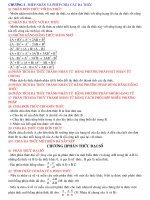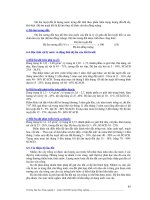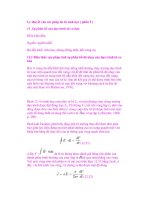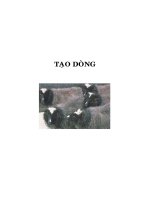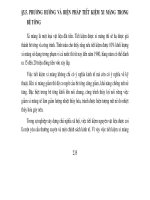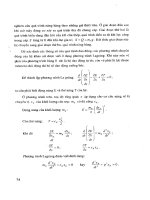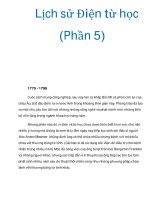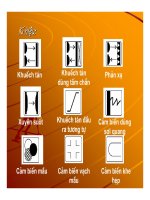Fiber Optic Telecommunication phần 5 ppsx
Bạn đang xem bản rút gọn của tài liệu. Xem và tải ngay bản đầy đủ của tài liệu tại đây (1022.05 KB, 14 trang )
F
UNDAMENTALS OF
P
HOTONICS
334 © 2000 University of Connecticut
C. Connectors
Many types of connectors are available for fiber optics, depending on the application. The most
popular are:
SC—snap-in single-fiber connector
ST and FC—twist-on single-fiber connector
FDDI—fiber distributed data interface connector
In the 1980s, there were many different types and manufacturers of connectors. Today, the
industry has shifted to standardized connector types, with details specified by organizations
such as the Telecommunications Industry Association, the International Electrotechnical
Commission, and the Electronic Industry Association.
Snap-in connector (SC)—developed by Nippon Telegraph and Telephone of Japan. Like most
fiber connectors, it is built around a cylindrical ferrule that holds the fiber, and it mates with an
interconnection adapter or coupling receptacle. A push on the connector latches it into place,
with no need to turn it in a tight space, so a simple tug will not unplug it. It has a square cross
section that allows high packing density on patch panels and makes it easy to package in a
polarized duplex form that ensures the fibers are matched to the proper fibers in the mated
connector (Figure 8-33a).
(a) (b)
Courtesy of Siecor, Inc.
Figure 8-33
(a)
SC connector
(b)
ST connector
Twist-on single-fiber connectors (ST and FC)—long used in data communication; one of
several fiber connectors that evolved from designs originally used for copper coaxial cables (see
Figure 8-33b)
Duplex connectors—A duplex connector includes a pair of fibers and generally has an internal
key so it can be mated in only one orientation. Polarizing the connector in this way is important
F
IBER
O
PTIC
T
ELECOMMUNICATION
© 2000 University of Connecticut 335
because most systems use separate fibers to carry signals in each direction, so it matters which
fibers are connected. One simple type of duplex connector is a pair of SC connectors, mounted
side by side in a single case. This takes advantage of their plug-in-lock design.
Other duplex connectors have been developed for specific types of networks, as part of
comprehensive standards. One example is the fixed-shroud duplex (FSD) connector specified by
the fiber distributed data interface (FDDI) standard (see Figure 8-34).
Figure 8-34 FDDI connector
D. Fiber Optic Couplers
A fiber optic coupler is a device used to connect a single (or multiple) fiber to many other
separate fibers. There are two general categories of couplers:
• Star couplers (Figure 8-35a)
• T-couplers (Figure 8-35b)
(a) (b)
Figure 8-35
(a)
Star coupler
(b)
T-coupler
F
UNDAMENTALS OF
P
HOTONICS
336 © 2000 University of Connecticut
Transmissive type
Optical signals sent into a mixing block are available at all output fibers (Figure 8-36). Power is
distributed evenly. For an n × n star coupler (n-inputs and n-outputs), the power available at
each output fiber is 1/n the power of any input fiber.
Figure 8-36 Star couplers
(a)
Transmissive
(b)
Reflective
The output power from a star coupler is simply
P
o
= P
in
/n
(8-27)
where n = number of output fibers.
The power division (power splitting ratio) in decibels is given by Equation 8-28.
PD
st
(dB) = –10 log(1/n)
(8-28)
The power division in decibels gives the number of decibels apparently lost in the coupler from
single input fiber to single fiber output. Excess power loss (Loss
ex
) is the power lost from input
to total output, as given in Equation 8-29 or 8-30.
out
ex
in
(total)
Loss
P
P
=
(8-29)
out
ex/dB
in
(total)
Loss –10log
P
P
=
(8-30)
Example 10
An 8
×
8 star coupler is used in a fiber optic system to connect the signal from one computer to
eight terminals. If the power at an input fiber to the star coupler is 0.5 mW, find (1) the power at
each output fiber and (2) the power division in decibels.
F
IBER
O
PTIC
T
ELECOMMUNICATION
© 2000 University of Connecticut 337
Solution:
1. The 0.5-mW input is distributed to eight fibers. Each has (0.50 mW)/8 = 0.0625 mW.
2. The power division, in decibels, from Equation 8-28 is
PD
ST
= –10
×
log(1/8) = 9.03 dB
Example 11
A 10
×
10 star coupler is used to distribute the 3-dBm power of a laser diode to 10 fibers. The
excess loss (Loss
ex
) of the coupler is 2 dB. Find the power at each output fiber in dBm and µW.
Solution:
The power division in dB from Equation 8.28 is
PD
st
= –10
×
log (1/10) = 10 dB
To find
P
out
for each fiber, subtract PD
st
and Loss
ex
from
P
in
in dBm:
3 dBm – 10 dB –– 2 dB = –9 dBm
To find
P
out
in watts we use Equation 8-3:
–9 = 10
×
log(
P
out
/1 mW)
P
out
= (1 mW)(10
–0.9
)
Solving, we get
P
out
= 126 µW
An important characteristic of transmissive star couplers is cross talk or the amount of input
information coupled into another input. Cross coupling is given in decibels and is typically
greater than 40 dB.
The reflective star coupler has the same power division as the transmissive type, but cross talk
is not an issue because power from any fiber is distributed to all others.
T-couplers
In Figure 8-37, power is launched into port 1 and is split between ports 2 and 3. The power split
does not have to be equal. The power division is given in decibels or in percent. For example,
and 80/20 split means 80% to port 2, 20% to port 3. In decibels, this corresponds to 0.97 dB for
port 2 and 6.9 dB for port 3.
F
UNDAMENTALS OF
P
HOTONICS
338 © 2000 University of Connecticut
Figure 8-37 T-coupler
10 log (P
2
/P
1
) = –0.97 dB
10 log (P
3
/P
1
) = –6.96 dB
Directivity describes the transmission between the ports. For example, if P
3
/P
1
= 0.5, P
3
/P
2
does
not necessarily equal 0.5. For a highly directive T-coupler, P
3
/P
2
is very small. Typically, no
power is expected to be transferred between any two ports on the same side of the coupler.
Another type of T-coupler uses a graded-index (GRIN) lens and a partially reflective surface to
accomplish the coupling. The power division is a function of the reflecting mirror. This coupler
is often used to monitor optical power in a fiber optic line.
E. Wavelength-Division Multiplexers
The couplers used for wavelength-division multiplexing (WDM) are designed specifically to
make the coupling between ports a function of wavelength. The purpose of these couplers is to
separate (or combine) signals transmitted at different wavelengths. Essentially, the transmitting
coupler is a mixer and the receiving coupler is a wavelength filter. Wavelength-division
multiplexers use several methods to separate different wavelengths depending on the spacing
between the wavelengths. Separation of 1310 nm and 1550 nm is a simple operation and can be
achieved with WDMs using bulk optical diffraction gratings. Wavelengths in the 1550-nm
range that are spaced at greater than 1 to 2 nm can be resolved using WDMs that incorporate
interference filters. An example of an 8-channel WDM using interference filters is given in
Figure 8-38. Fiber Bragg gratings are typically used to separate very closely spaced
wavelengths in a DWDM system (< 0.8 nm).
F
IBER
O
PTIC
T
ELECOMMUNICATION
© 2000 University of Connecticut 339
(Courtesy of DiCon, Inc.)
Figure 8-38 8-channel WDM
Erbium-doped fiber amplifiers (EDFA)—The EDFA is an optical amplifier used to boost the
signal level in the 1530-nm to 1570-nm region of the spectrum. When it is pumped by an
external laser source of either 980 nm or 1480 nm, signal gain can be as high as 30 dB
(1000 times). Because EDFAs allow signals to be regenerated without having to be converted
back to electrical signals, systems are faster and more reliable. When used in conjunction with
wavelength-division multiplexing, fiber optic systems can transmit enormous amounts of
information over long distances with very high reliability.
Figure 8-39 Wavelength-division multiplexing system using EDFAs
Fiber Bragg gratings—Fiber Bragg gratings are devices that are used for separating
wavelengths through diffraction, similar to a diffraction grating (see Figure 8-40). They are of
critical importance in DWDM systems in which multiple closely spaced wavelengths require
F
UNDAMENTALS OF
P
HOTONICS
340 © 2000 University of Connecticut
separation. Light entering the fiber Bragg grating is diffracted by the induced period variations
in the index of refraction. By spacing the periodic variations at multiples of the half-wavelength
of the desired signal, each variation reflects light with a 360° phase shift causing a constructive
interference of a very specific wavelength while allowing others to pass. Fiber Bragg gratings
Figure 8-40 Fiber Bragg grating
are available with bandwidths ranging from 0.05 nm to >20 nm. Fiber Bragg grating are
typically used in conjunction with circulators, which are used to drop single or multiple narrow-
band WDM channels and to pass other “express” channels (see Figure 8-41). Fiber Bragg
gratings have emerged as a major factor, along with EDFAs, in increasing the capacity of next-
generation high-bandwidth fiber optic systems.
Courtesy of JDS-Uniphase
Figure 8-41 Fiber optic circulator
Figure 8-42 depicts a typical scenario in which DWDM and EDFA technology is used to
transmit a number of different channels of high-bandwidth information over a single fiber.
As shown, n-individual wavelengths of light operating in accordance with the ITU grid are
multiplexed together using a multichannel coupler/splitter or wavelength-division multiplexer.
An optical isolator is used with each optical source to minimize troublesome back reflections.
A tap coupler then removes 3% of the transmitted signal for wavelength and power monitoring.
Upon traveling through a substantial length of fiber (50-100 Km), an EDFA is used to boost the
signal strength. After a couple of stages of amplifications, an add/drop channel consisting of a
fiber Bragg grating and circulator is introduced to extract and then reinject the signal operating
at the λ
3
wavelength. After another stage of amplification via EDFA, a broadband WDM is
used to combine a 1310-nm signal with the 1550-nm window signals. At the receiver end,
another broadband WDM extracts the 1310-nm signal, leaving the 1550-nm window signals.
The 1550-nm window signals are finally separated using a DWDM that employs an array of
F
IBER
O
PTIC
T
ELECOMMUNICATION
© 2000 University of Connecticut 341
fiber Bragg gratings, each tuned to the specific transmission wavelength. This system represents
the current state of the art in high-bandwidth fiber optic data transmission.
Figure 8-42 Typical DWDM transmission system
(Courtesy of Newport Corporation)
What’s ahead?
Over the past five years, major breakthroughs in technology have been the impetus for
tremendous growth experienced by the fiber optic industry. The development of EDFAs, fiber
Bragg gratings and DWDM, as well as advances in optical sources and detectors that operate in
the 1550-nm range, have all contributed to advancing the fiber optics industry to one of the
fastest growing and most important industries in telecommunication today. As the industry
continues to grow, frustrating bottlenecks in the “information superhighway” will lessen, which
will in turn usher in the next generation of services, such as telemedicine, Internet telephony,
distance education, e-commerce, and high-speed data and video. More recent advances in
EDFAs that operate at 1310-nm and 1590-nm technology will allow further enhancement in
fiber optic systems. The future is bright. Just remember, the information superhighway is paved
with glass!
F
UNDAMENTALS OF
P
HOTONICS
342 © 2000 University of Connecticut
Problem Exercises/Questions
1. A fiber of 1-km length has P
in
= 1 mW and P
out
= 0.125 mW. Find the loss in dB/km.
2. A communication system uses 8 km of fiber that has a 0.8-dB/km loss characteristic. Find
the output power if the input power is 20 mW.
3. A 5-km fiber optic system has an input power of 1 mW and a loss characteristic of
1.5 dB/km. Determine the output power.
4. What is the maximum core diameter for a fiber to operate in single mode at a wavelength
of 1310 nm if the N.A. is 0.12?
5. A 1-km-length multimode fiber has a modal dispersion of 0.50 ns/km and a chromatic
dispersion of 50 ps/km
•
nm. If it is used with an LED with a linewidth of 30 nm, (a) what
is the total dispersion? (b) Calculate the bandwidth (BW) of the fiber.
6. A digital MUX operates with 16 sources. The rate of data in each source is
8000 bytes/second (assume 8 bits per byte). Data are transmitted byte by byte.
(a) What is the data rate of the MUX output?
(b) What is the channel switching rate?
7. A receiver has a sensitivity P
s
of –
40 dBm for a BER of 10
–9
. What is the minimum
power (in watts) that must be incident on the detector?
8. A system has the following characteristics:
• LED power (P
L
) = 1 mW (0 dBm)
• LED to fiber loss (L
sf
) = 3 dB
• Fiber loss per km (F
L
) = 0.2 dB/km
• Fiber length (L) = 100 km
• Connector loss (L
conn
) = 3 dB (3 connectors spaced 25 km apart with 1 dB of loss each)
• Fiber to detector loss (L
fd
) = 1 dB
• Receiver sensitivity (P
s
) = –
40 dBm
Find the loss margin and sketch the power budget curve.
9. A 5-km fiber with a BW × length product of 1200 MHz × km (optical bandwidth) is used
in a communication system. The rise times of the other components are t
tc
= 5 ns, t
L
= 1
ns, t
ph
= 1.5 ns, and t
rc
= 5 ns. Calculate the electrical BW for the system.
10. A 4 × 4 star coupler is used in a fiber optic system to connect the signal from one
computer to four terminals. If the power at an input fiber to the star coupler is 1 mW, find
(a) the power at each output fiber and (b) the power division in decibels.
11. An 8 × 8 star coupler is used to distribute the +3-dBm power of a laser diode to 8 fibers.
The excess loss (Loss
ex
) of the coupler is 1 dB. Find the power at each output fiber in
dBm and µW.
F
IBER
O
PTIC
T
ELECOMMUNICATION
© 2000 University of Connecticut 343
Laboratory: Making a Fiber Optic
Coupler
In this lab you will fabricate a 2 × 2 fiber optic coupler using 1-mm-diameter plastic fiber. The
coupler can be used for a variety of applications including wavelength-division multiplexing
and power splitting, which will be outlined in this lab.
Equipment List
The following equipment is needed to complete this laboratory.
2 1-foot sections of 1-mm-diameter plastic-jacketed fiber (Part #2705FIBOPT)
1
1 razor blade
1 heat gun
1 4" piece of heat-shrink tubing
2 high-brightness LEDs (1 green and 1 red)
2 plastic fiber connectors (Part #2400228087-1)
1
2 plastic fiber LED mounts (Part #2400228040-1)
1
4 multimode ST-connectors for 1-mm fiber (Part #F1-0065)
2
1 electronic breadboard with +5-volt supply
1 850-nm fiber optic source with ST adapter (Part #9050-0000)
2
1 850-nm fiber optic detector with ST adapter (Part #F1-8513HH)
2
1 low-cost diffraction grating (Part #J01-307)
3
1 1-meter patch cord (terminated with ST connectors)
1 fiber optic termination kit (includes scissors, alcohol wipes, crimp tool,
fiber-inspection microscope, razor blades, etc.)
1
(Notations 1, 2, 3: See sources in APPENDIX.)
Procedure
PART I: Making a Fiber Optic Coupler
1. With the razor blade, carefully strip off approximately 3" of the fiber jacket in the middle
of the fiber (see Figure 8-43).
F
UNDAMENTALS OF
P
HOTONICS
344 © 2000 University of Connecticut
Figure 8-43
2. Where the fiber has been stripped, twist the two fibers together.
3. On each end of the stripped area, place a small weight (i.e., paperweight, book) to hold
the fiber in place (see Figure 8-44).
Figure 8-44
4. Using the heat gun on the low setting, apply heat to the twisted area. Move the heat gun
gently back and forth to uniformly melt the fiber. CAUTION: Do not hold the heat gun
stationary because the fiber will melt quickly!
5. As the fiber is heated, you will notice that it will contract a bit. This is normal. When the
contraction subsides, remove the heat gun and let the fiber cool for a minute.
6. With a laser pointer or fiber optic source, shine light into port 1 of the coupler. You
should observe a fair amount of coupling (~20–30%) into port 3 of the coupler. If more
coupling is needed, repeat the heating process until the desired coupling is obtained.
PART II: Wavelength-Division Multiplexing Demonstration
1. Apply the AMP plastic fiber connectors to the two input fibers (ports 1 and 4) according
to manufacturer’s specifications. Polish the ends if necessary. Also polish the ends of the
unterminated fibers if necessary.
2. On the electronic breadboard, set up the circuit shown in Figure 8-45. Depending on the
type of LED, you may have to use epoxy to secure the LED in the mount.
F
IBER
O
PTIC
T
ELECOMMUNICATION
© 2000 University of Connecticut 345
Figure 8-45
3. When the circuit is complete, connect the fibers to the LEDs and observe the output of
port 2. The red and green colors will be mixed.
4. To separate the colors, observe the output of port 2 through the diffraction grating. You
should observe a central bright spot (coming from the fiber) and two identical diffraction
patterns—one on either side—with the red and the green separated (see Figure 8-46). To
ensure that the two signals are indeed independent, turn off the LEDs one at a time and
observe the output of port 2 through the diffraction grating.
F
UNDAMENTALS OF
P
HOTONICS
346 © 2000 University of Connecticut
Figure 8-46
Part III: Measuring Coupler Loss
1. Repeat steps 1–6 (Part I) for fabrication of a 2 × 2 coupler.
2. “Connectorize” each port of the coupler using ST-multimode connectors and polish if
necessary. (Instructions for termination are supplied with the connectors when
purchased.)
3. Measure the output of your fiber optic source at the output of the patch cord. This will be
the input power to the coupler. Record the power in Table 8.6.
4. Measure the output power at each of the ports and record in Table 8.6.
5. Calculate the throughput loss using the following equation:
L
th
= –10 log (P
2
/P
1
)
6. Calculate the tap loss using the following equation:
L
tap
= –10 log (P
3
/P
1
)
7. Calculate the directionality loss using the following equation:
L
dir
= –10 log (P
4
/P
1
)
F
IBER
O
PTIC
T
ELECOMMUNICATION
© 2000 University of Connecticut 347
8. Calculate the excess loss using the following equation:
L
ex
= –10 log (P
2
+ P
3
)/P
1
9. Repeat Part III – steps 3–9 using each port as the input. Record the results in Table 8.6.
Table 8.6
Input
Port
Input Power
(mW)
Throughput
Loss (dB)
Directionality
Loss (dB)
Tap Loss
(dB)
Excess
Loss (dB)
1
2
3
4
APPENDIX
1. Items may be obtained through
Electronix Express
365 Blair Road
Avenel, NJ 07001
1-800-972-2225
2. Items may be obtained through
Fiber Instrument Sales (FIS)
161 Clear Road
Oriskany, NY 13424
1-800-500-0347
3. Items may be obtained through
Edmund Scientific, Inc.
101 East Gloucester Pike
Barrington, NJ 08007
856-573-6250
